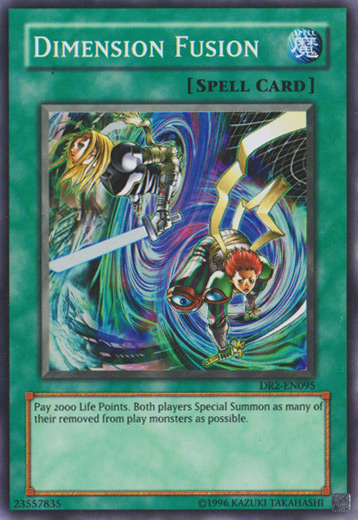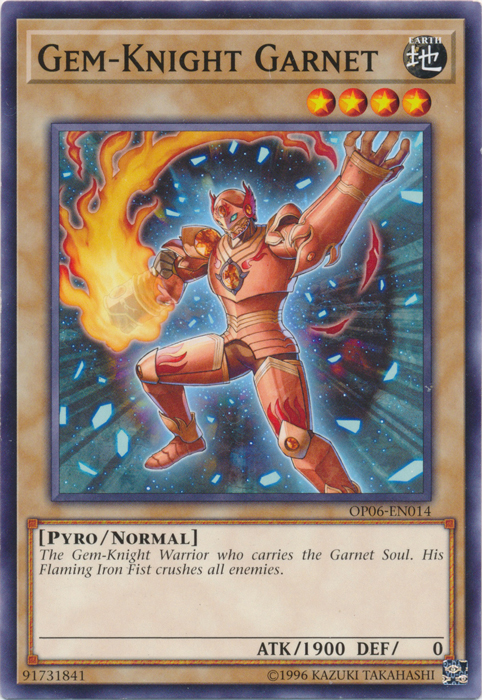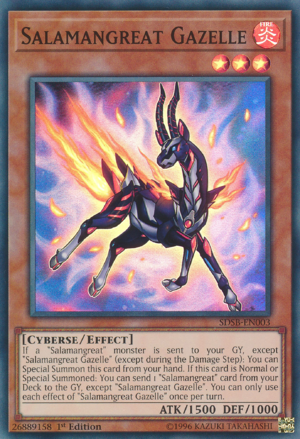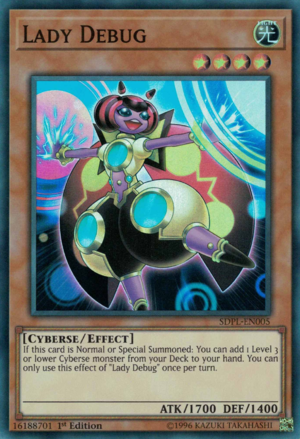How many copies should you play?
“Banish 10 cards from the top of your Deck, face-down; draw 2 cards. You can only activate 1 “Pot of Desires” per turn.”
A simple concept, and if there’s one thing you can count on players to do, it’s flock to a card when it says ‘draw 2 cards.’ No matter how bad the card is.

So why such hesitation on Pot of Desires? Well, the other thing you can be sure of, it’s that players are “Risk Averse”. I’ve spent a great deal of time studying/teaching Deck Building and game theory in Yu-Gi-Oh!, and one thing that remains constant is that the game’s playerbase is so risk averse that they will avoid even the best cards in the game for a very, very long time. Whether it was Solemn Judgment for the first 7 years it was in print, or even arguably the most powerful Spell in the game, Dimension Fusion, being at 3 for the famous ‘Goat Format’. A much more recent but still powerfully relevant example of this is the game’s most divisive card in our current metagame: Pot of Desires.
KONAMI really struck gold with this card. It’s allowed them to have the famous “Pot of Greed” in the game for those with the courage to grab for it, and keep it at 3 without a single person complaining. The card has helped carry an entire set with its commanding launch price tag, further still been an OTS Ultimate Rare, and now it’s even a Collector’s Rare in Toon Chaos. Recently, it helped carry a wave of tins, and an entire Structure Deck.
This card has gotten a ton of mileage over the years as something so good everybody wants it, but somehow, so risky that I’ve never once seen somebody suggest it even be semi-limited. In fact the playerbase, more often than not, does that to themselves anyway. The question is, should they?
Warning. Math Section.
Let’s start with the obvious. 10 cards is a lot. It’s as much as 25% of your Decklist. We can very quickly get the risk factors covered, as they’ve been explained to death by now.
I’m going to just simply show you the likelihoods of each factor, if the first card you play in a duel is Pot of Desires: going first and going second. A lot of people know these numbers, and they’ve been accurately calculated. They are however, the only ones that have been. More on that after.
Brief Math Section Probability of drawing into 1-2 copies of Desires (aka, at least 1 copy), from activating Desires: Probability of banishing all 3 copies of a specific card (e.g. 3 copies of Evenly Matched): Probability of banishing both copies of a specific card (e.g. your Deck only contains 2 copies of Destiny HERO – Malicious): Probability of banishing your only (1) copy of a specific card:
Spoiler
You will see three numbers, all based on a 5-card starting hand drawn from a standard 40-card Deck. The first is ‘Going first, without activating Upstart Goblin‘. That is, 35 cards remaining in your Deck. The second is ‘Going first, after activating Upstart’ (which is the same as “going second”): a 34-card Deck. The third is ‘Going second, after activating Upstart’, which is a 33-card Deck.
11.26% / 11.59% / 11.93%
1.83% / 2.01% / 2.20%
7.56% / 8.02% / 8.52%
28.57% / 29.41% / 30.3%
These numbers only tell half the story. We don’t play cards in our Deck just to pay their costs unless you’re playing Toons. We play Desires to see the cards we’re drawing from its effect. By having this card in our Deck and drawing two cards, we see more of our better (and unsearchable) options more often, as well as having more options in our hand, since the hand-size increases by 1.
 There’s also the additional risk involved with Engine Requirement cards, such as Gem-Knight Garnet or Altergeist Haunted Rock. These cards come in three classes, and we’ll discuss those in another article, but if you banish these, or even in some cases draw them, you can render powerful cards in your Deck unable to resolve. This is very important to consider when using Pot of Desires in a Deck.
There’s also the additional risk involved with Engine Requirement cards, such as Gem-Knight Garnet or Altergeist Haunted Rock. These cards come in three classes, and we’ll discuss those in another article, but if you banish these, or even in some cases draw them, you can render powerful cards in your Deck unable to resolve. This is very important to consider when using Pot of Desires in a Deck.
Furthermore, there’s factoring in the odds you see a copy of Desires at all. It’s one thing to say it’s a 1.83% chance to banish your three copies of Altergeist Meluseek, but that doesn’t mean 1.83% of your games you’ll be playing without it. This is a very common misconception with the card, and an additional step to working it out that most people tend to overlook. If you ran 3 copies of Pot of Desires, and all things being equal, you just always activated it before any other cards, you’d banish all 3 copies of your card 0.44% of the time. That’s 44 out of 10000, or once every 227 games. To really exaggerate how dramatic this is, even if you went to game 3 of every match, this would happen to you one in every 75 matches, or, once every 6 YCS events. The risk of losing all 3 copies of your “Sky Striker Ace – Raye” to “Pot of Desires” is so small you can essentially ignore it completely.
Lastly is something I like to call “Hard vs Soft copies”.
Hard Copies
A hard copy is a card in your Deck you’re hoping you draw with Desires (the goal of your Deck’s engine, such as Altergeist Multifaker, or Salamangreat Gazelle). These are the cards that scare people when it comes to using Pot of Desires, because ‘what if I banish all my copies of it?’

Soft copies
Soft copies are like an additional copy of the “hard copy” cards, except that it doesn’t matter if you banish a soft copy. Cards like Reinforcement of the Army and Lady Debug that, when drawn, still search your Deck for your desired cards (no pun intended) are still seen as a successful draw, so long as you didn’t banish all of your hard copies. However, banishing every single soft copy still has no negative effect on the outcome of Desires.

With all this in mind, let’s take a look at the benefits of Pot of Desires instead, and see why we’re really here. This time, instead of the odds we banish our tools, let’s see how often we can draw them.
Another Math Section Probability of drawing a card you play 3 of, from activating Desires Probability of drawing a card you only play 2 of, from activating Desires Probability of drawing a card you only play 1 of, from activating Desires
Spoiler
You will see three numbers, which assume the same as before: a 5-card starting hand with a 40-card Deck. The first is ‘Going first no Upstart’ (35 cards remaining in Deck). The second is ‘Going first with Upstart’, which is the same as using Desires going second; a 34-card Deck. The third is ‘Going second and using Upstart’ (a 33-card Deck).
16.64% / 17.11% / 17.61%
11.26% / 11.59% / 11.93%
5.71% / 5.88% / 6.06%
How to apply soft copies to these numbers.
A near +18% in consistency in seeing your best cards sounds phenomenal I’m sure, but again, it doesn’t paint the whole picture. For starters, we didn’t look at soft copies whatsoever. Secondly, we again aren’t factoring in the odds we see Pot of Desires! A friend of mine and I have spent several weeks now tweaking and calculating a tool for using Pot of Desires, which will be made publicly available in a future YGOrganization update, and in this article I’m going to show you how to use it.
I can tell you from using the tool that 7 soft copies is the requirement for using Pot of Desires in a Deck with a Limited “hard copy” card. A current and specific example of this would be the Salamangreat Deck. Presently, Salamangreat Gazelle (our hard copy) is Limited. We therefore require 7 soft copies of Gazelle before Pot of Desires produces a net benefit. These “soft copies” would be 3 copies of Lady Debug, 3 copies of Cynet Mining, and 1 copy of Salamangreat Circle.
Base Consistency Ratio
There are two reasons to run, or not run, Pot of Desires. The first is the Overall Success (net benefit) that the card brings to your Deck. The second is the Benefit-Base Consistency Ratio. This is a simple calculation of that “net benefit” divided by the Chance to draw ANY desired cards, and no Engine Requirement cards, naturally – all without using Desires. Put simply, if your Deck is already so consistent that you’re going to see Altergeist Multifaker 99% of the time anyway, adding the risk of Pot of Desires isn’t worth the marginal boost to consistency at seeing the card. It’s a judgment call, and will vary from Deck to Deck as you have more cards you’d want to see, and the additional card in hand is almost always worth it anyway, but the tool does account for this ratio just in case.
Net Value Gained
The Overall Success however, is dependent on how often Desires is seen, vs how often Desires is successfully drawing what we want, vs how often Desires is failing us by banishing our needed cards. This also factors in banishing, or even drawing, your Engine Requirement cards. We call this the ‘Complete Failure Rate’. The chance to mill OR draw any engine requirements, OR mill all copies of your desired card. Subtract the Complete Failure Rate from the Overall Success rate (the total success rate of Desires seeing the card you want, against the likelihood you see Desires at all) and you get a net value. If this is a negative number, it means Pot of Desires is losing you more games than it’s winning you.
This is essentially all a fancy way to show, and prove, that any Deck that should use Pot of Desires, which is almost every Deck, should be playing 3 Pot of Desires. No less.
Here’s a video of me using the tool from our YouTube Channel. I’ve been showing it off lately on the YGOrganization Twitch channel, and posting about it non-stop in our Discord Server, so be sure to check these out for more tools and other useful information.
https://www.youtube.com/watch?v=O9NWZOm6kWU

![[Strategy Guide] Pot of Desires](https://cdn.ygorganization.com/2020/07/PotofDesires-TOCH-EN-R-1E.png)